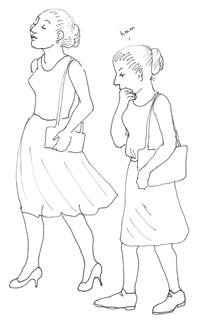STRANGE BUT TRUE- Arched back: And other sexy reasons for heels

DRAWING BY DEBORAH DERR McCLINTOCK
Q. If high heels are uncomfortable and make walking more difficult, and prolonged use can injure the feet, knees and back, why do women keep wearing them?–N. Kidman
A. The short answer would seem to be that women in heels attract more favorable notice, says Robert H. Frank in The Economic Naturalist.
Author Jane Austen once described her character Elinor Dashwood as having a "remarkably pretty figure," but her sister was handsomer still, because though "her form was not so correct as her sister's, in having the advantage of height, she was more striking."
In addition to making women taller, high heels force the back to arch, pushing the bosom forward and the buttocks rearward, thus accentuating the female form. And, wrote fashion historian Caroline Cox, "men like an exaggerated female figure."
Still, while it may be advantageous to be several inches taller than others, or at least not shorter, when all women wear height-enhancing shoes, such advantages tend to cancel out.
"If women could decide collectively what kind of shoes to wear, all might agree to forgo high heels," Cox wrote. "But because any individual can gain advantage by wearing them, such an agreement might be hard to maintain."
Q. Baseball fans, try to imagine how your brain might behave at a game.–W. Mays
A. You certainly won't forget to take along your "prefrontal cortex," important for planning, reasoning, social cognition, says Jordan Grafman, PhD, in Your Brain on Cubs: Inside the Heads of Players and Fans.
This is the part responsible for retrieving knowledge about the other team and informing you what your beloved team must do to win. Bonding with friends at the game activates regions that release chemicals signalling feelings of pleasure. The prefrontal cortex also holds your sense of self, including memories of long-ago activities like playing ball in your youth.
More posterior brain regions concerned with visual, auditory, and even tactile perception, plus the emotion-centered limbic system all become activated when you see the familiar green field, smell the hot dogs, hear "Take Me Out to the Ball Game."
In that case, your brain's reward system pumps out dopamine, like the experience of downing a congratulatory beer (whose effects involve the same reward system). All in all, your brain gets you to return to the ballpark again and again.
Q. Can you figure the total length of all the hairs on an average woman's head?–S. O'Connor
A. Start by estimating the area of the scalp, then the number of hairs per square centimeter (sq. cm), then the length of a typical strand, say Lawrence Weinstein and John A. Adam in Guestimation: Solving the World's Problems on the Back of a Cocktail Napkin.
As for the area, note that one hand-span, or about 8 inches (20 cm), approximates the diameter of the roughly spherical head, making the scalp a hemisphere of about 600 sq. cm.
Next, count the hairs along a 1 cm length, then square it. Suppose there are 1-2 hairs per millimeter, or 10-20 per cm, tallying to 100-400 hairs per sq. cm. If you use the figure of 200, the total number on a head is about 600 x 200, or roughly 100,000 hairs. (Blonde hair is typically finer and more closely spaced so answers may vary._
Finally, a typical hair may range from 1 cm (.5 inch) to 100 cm (1 meter or 3 feet), so you might use 10 cm (4 inches), or about shoulder length.
"This means the total length of all the hairs on a woman's head is about 100,000 hairs x 10 cm/hair = 1,000,000 cm = 10,000 meters = 10 kilometers (km)," or about 6 miles. Short hair would amount to about 1 km and really long hair 100 km, or 60 miles.
Q. It's an electromagnetic jungle out there for patients with cardiac pacemakers. What "beasts" lurk?–R. Jarvik
A. Older microwave ovens and computers, big TV screens, electrical heaters, fluorescent lights, even casino slot machines are all ready to pounce, says Duke University biomedical engineer and pediatrics professor Roger Barr. The patient-cum-pacemaker should also be sure to pass briskly through airport metal detectors and stand away from detectors in stores (slow checkout lines are a pitfall).
Yet, though lots of things can cause problems, especially with older pacemakers, overall the risk is low, as most pacemakers are well shielded against interference, says Barr. Often, only a few heartbeats are affected, then the person realizes what's happening and moves away.
Also, contrary to popular belief, such as the guy who felt his pacemaker was switching channels on nearby TVs, the pacemaker signals are likely too weak to create interference with electrical devices around them.
~
Send strange questions to brothers Bill and Rich at [email protected].
#